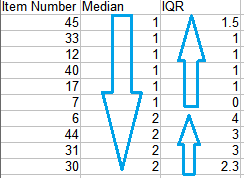Statistics Definitions > Thurstone Scale
What is the Thurstone Scale?
A Thurstone scale has a number of “agree” or “disagree” statements. It is a unidimensional scale to measure attitudes towards people. Developing the scale is time consuming and relatively complex compared to other scales (like the Likert scale); You can find the steps below.
Although there are technically three scales, when people refer to the “Thurstone Scale” they’re usually talking about the method of equal-appearing intervals. It’s called “Equal appearing intervals” because when you choose the items for your test (see Step 6 below), you’re picking items equally spaced apart.
The other two variations are:
- The method of successive intervals: this method is more challenging to implement than equal-appearing intervals.
- The method of paired comparisons: requires twice the judgments than the equal-appearing intervals method and can quickly become very consuming.
The three methods differ in their construction, but still result in the same Agree/Disagree quiz given to respondents.
Method of Equal-Appearing Intervals
Step 1: Develop a large number of agree/disagree statements for a topic. For example, if you wanted to find out people’s attitudes towards immigrants, your statements might include:
- Immigrants drain social services.
- Immigrants take jobs away from regular people.
- Immigrants perform low-wage, unpopular tasks.
Step 2: Have a panel of judges rate the items on a scale of 1 to 11 for how favorable each item is towards the topic (in this case, immigration). The lowest score(1) should indicate an extremely unfavorable attitude and the highest score(11) should indicate an extremely favorable attitude. Note that you do not want the judges to agree or disagree with the statements — you want them to rate the statements on how effective they would be at uncovering attitudes.
Step 3: Find the median score and interquartile range(IQR) for each item. If you have 50 items, you should have 50 median scores and 50 IQRs.
How to Find the Median.
How to Find the Interquartile Range.
Step 4: Sort the table in ascending order(smallest to largest) by median. In other words, the 1s should be at the top of the table and the 11s should be at the bottom.
Step 5:For each set of medians (i.e. 1s. 2s, 3s) sort the IQRs by descending order (largest to smallest).
The figure below shows a partial table with the data sorted according to ascending medians with their respective, descending IQRs.

Step 6: Select your final scale items using the table you created in Step 4 and 5. For example, you might choose one item from each median value.
You want the statements with the most agreement between judges. For each median value, this is the item with the lowest interquartile range. This is a “Rule of Thumb”: you don’t have to choose this item. If you decide it’s poorly worded or ambiguous, choose the item above it (with the next lowest IQR).
Scoring the Scale
You should now have a scale of items that’s ready to administer. Add a check box (or radio button) with “Agree” or “Disagree” and you’re ready to go! To score the questionnaire, simply calculate the percentage of agreed. For example, if a person answers 4 out of 11 questions as “agree”, then that person has a score of 4/11 = 36%. The lower a score, the less favorable the opinion. For example, a person with a score of 2 views the topic a lot less favorably that a person with a score of 8.
References
Babbie, E., ‘The Practice of Social Research‘, 10th edition, Wadsworth, Thomson Learning Inc.
Edwards, A. L. Techniques of attitude scale construction. New York: Appleton-Century- Crofts, 1957.